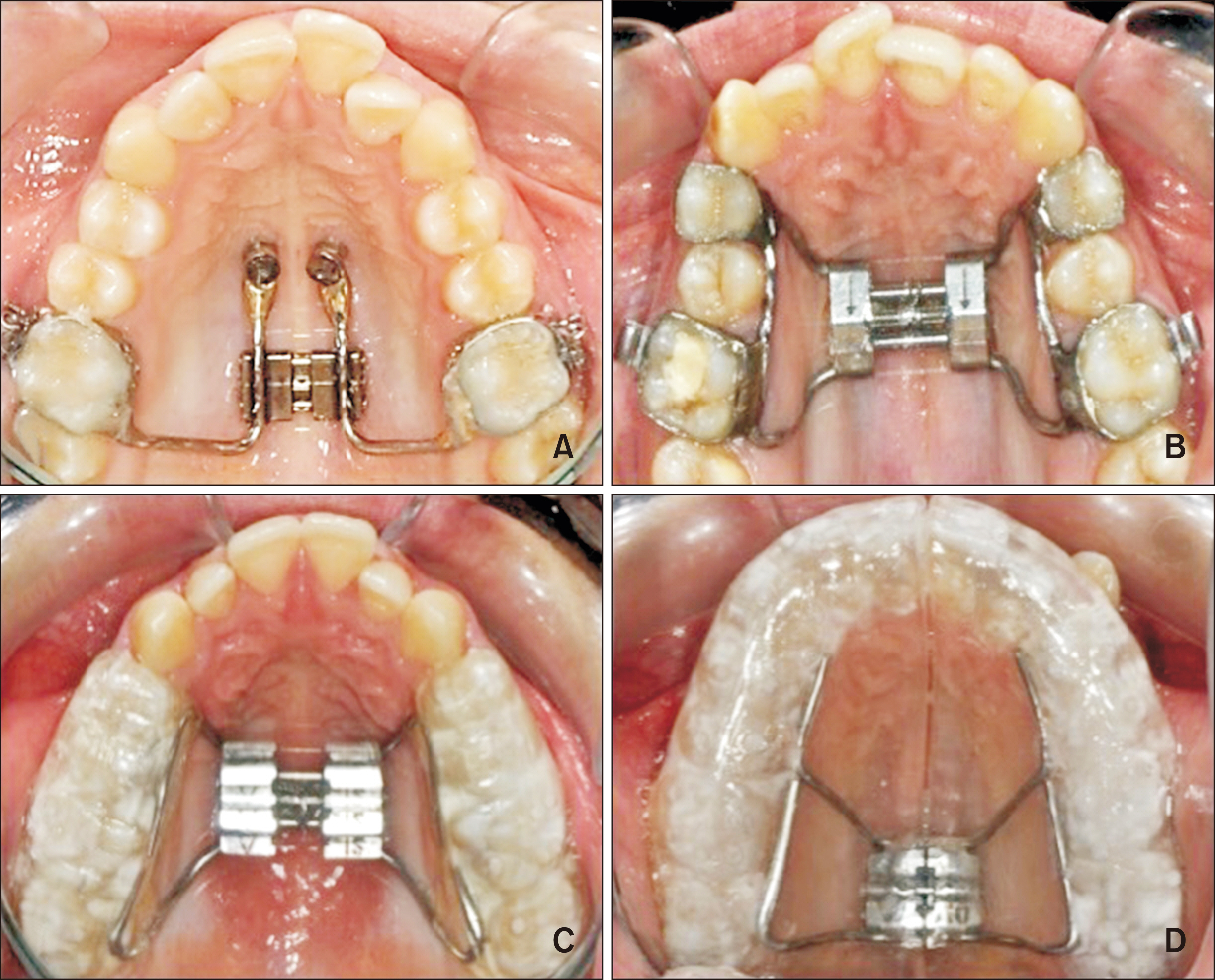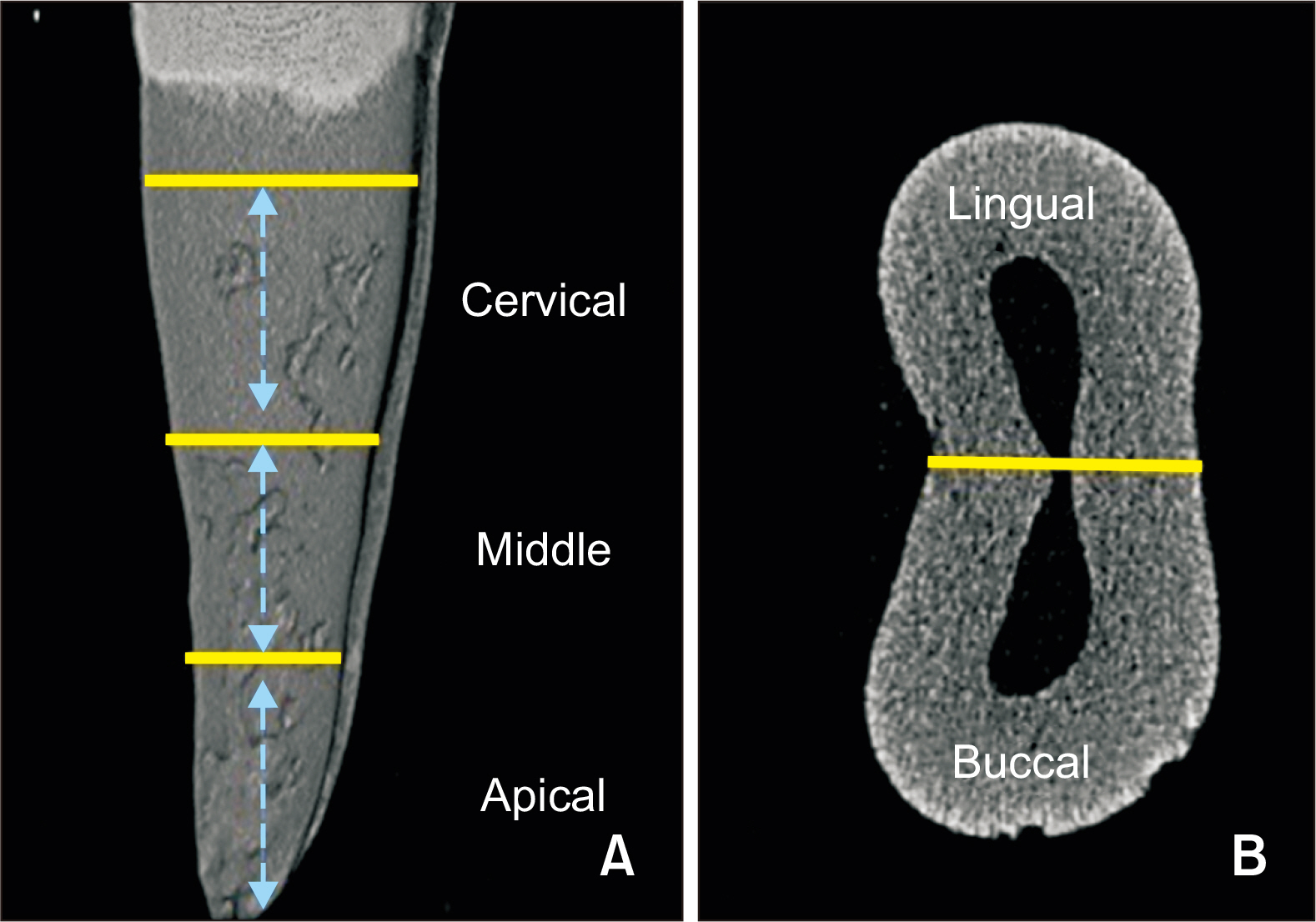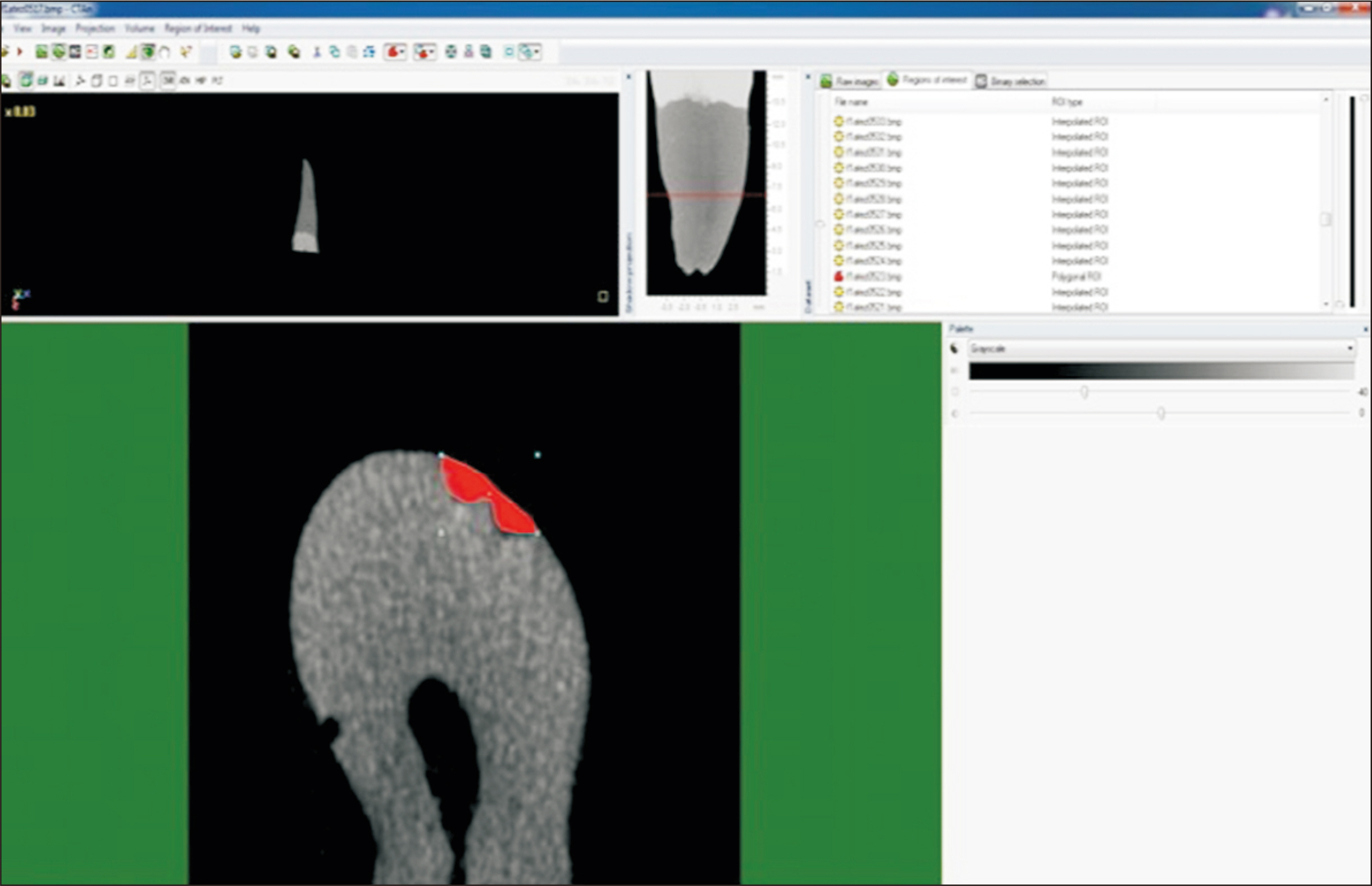Korean J Orthod.
2021 Jul;51(4):241-249. 10.4041/kjod.2021.51.4.241.
Does mini-implant-supported rapid maxillary expansion cause less root resorption than traditional approaches? A micro-computed tomography study
- Affiliations
-
- 1Private Practice, Adana, Turkey
- 2Private Practice, Istanbul, Turkey
- KMID: 2518517
- DOI: http://doi.org/10.4041/kjod.2021.51.4.241
Abstract
Objective
This study aimed to evaluate the volume, amount, and localization of root resorption in the maxillary first premolars using micro-computed tomography (micro-CT) after expansion with four different rapid maxillary expansion (RME) appliances.
Methods
In total, 20 patients who required RME and extraction of the maxillary first premolars were recruited for this study. The patients were divided into four groups according to the appliance used: miniimplant-supported hybrid RME appliance, hyrax RME appliance, acrylic-bonded RME appliance, and full-coverage RME appliance. The same activation protocol (one activation daily) was implemented in all groups. For each group, the left and right maxillary first premolars were scanned using micro-CT, and each root were divided into six regions. Resorption craters in the six regions were analyzed using special CTAn software for direct volumetric measurements. Data were statistically analyzed using Kruskal–Wallis one-way analysis of variance and Mann–Whitney U test with Bonferroni adjustment.
Results
The hybrid expansion appliance resulted in the lowest volume of root resorption and the smallest number of craters (p < 0.001). In terms of overall root resorption, no significant difference was found among the other groups (p > 0.05). Resorption was greater on the buccal surface than on the lingual surface in all groups except the hybrid appliance group (p < 0.05).
Conclusions
The findings of this study suggest that all expansion appliances cause root resorption, with resorption craters generally concentrated on the buccal surface. However, the mini-implant-supported hybrid RME appliance causes lesser root resorption than do other conventional appliances.
Figure
Reference
-
1. Almuzian M, Short L, Isherwood G, Al-Muzian L, McDonald J. 2016; Rapid maxillary expansion: a review of appliance designs, biomechanics and clinical aspects. Orthod Update. 9:90–5. DOI: 10.12968/ortu.2016.9.3.90.
Article2. Erverdi N, Okar I, Kücükkeles N, Arbak S. 1994; A comparison of two different rapid palatal expansion techniques from the point of root resorption. Am J Orthod Dentofacial Orthop. 106:47–51. DOI: 10.1016/S0889-5406(94)70020-6. PMID: 8017349.3. Odenrick L, Karlander EL, Pierce A, Kretschmar U. 1991; Surface resorption following two forms of rapid maxillary expansion. Eur J Orthod. 13:264–70. DOI: 10.1093/ejo/13.4.264. PMID: 1915614.
Article4. Barber AF, Sims MR. 1981; Rapid maxillary expansion and external root resorption in man: a scanning electron microscope study. Am J Orthod. 79:630–52. DOI: 10.1016/0002-9416(81)90356-0. PMID: 7015868.
Article5. Langford SR. 1982; Root resorption extremes resulting from clinical RME. Am J Orthod. 81:371–7. DOI: 10.1016/0002-9416(82)90074-4. PMID: 6758597.
Article6. Akyalcin S, Alexander SP, Silva RM, English JD. 2015; Evaluation of three-dimensional root surface changes and resorption following rapid maxillary expansion: a cone beam computed tomography investigation. Orthod Craniofac Res. 18 Suppl 1:117–26. DOI: 10.1111/ocr.12069. PMID: 25865540.
Article7. Yildirim M, Akin M. 2019; Comparison of root resorption after bone-borne and tooth-borne rapid maxillary expansion evaluated with the use of microtomography. Am J Orthod Dentofacial Orthop. 155:182–90. DOI: 10.1016/j.ajodo.2018.03.021. PMID: 30712689.
Article8. Malkoç S, İşeri H, Durmuş E. 2012; Semirapid maxillary expansion and mandibular symphyseal distraction osteogenesis in adults: a five-year follow-up study. Semin Orthod. 18:152–61. DOI: 10.1053/j.sodo.2011.10.013.
Article9. Orhan M, Üsümez S, Malkoç S. 2009; Modified bonded rapid maxillary expansion appliance. World J Orthod. 4:119–25. DOI: 10.1016/j.ajodo.2007.03.035,. PMID: 19201325.10. Dindaroğlu F, Doğan S. 2016; Evaluation and comparison of root resorption between tooth-borne and tooth-tissue borne rapid maxillary expansion appliances: a CBCT study. Angle Orthod. 86:46–52. DOI: 10.2319/010515-007.1. PMID: 25993251.
Article11. Ludwig B, Sebastian B, Bowman SJ. 2008. Mini-implants in orthodontics: innovative anchorage concepts. Quintessence Publishing;London:12. Kayalar E, Schauseil M, Kuvat SV, Emekli U, Fıratlı S. 2016; Comparison of tooth-borne and hybrid devices in surgically assisted rapid maxillary expansion: a randomized clinical cone-beam computed tomography study. J Craniomaxillofac Surg. 44:285–93. DOI: 10.1016/j.jcms.2015.12.001. PMID: 26782847.
Article13. Cheng LL, Türk T, Elekdağ-Türk S, Jones AS, Petocz P, Darendeliler MA. 2009; Physical properties of root cementum: part 13. Repair of root resorption 4 and 8 weeks after the application of continuous light and heavy forces for 4 weeks: a microcomputed-tomography study. Am J Orthod Dentofacial Orthop. 136:320.e1–10. discussion 320–1. DOI: 10.1016/j.ajodo.2008.05.014. PMID: 19732664.
Article14. Çelik Güler Ö, Malkoç S. 2019; Effects of orthodontic force on root surface damage caused by contact with temporary anchorage devices and on the repair process. Korean J Orthod. 49:106–15. DOI: 10.4041/kjod.2019.49.2.106. PMID: 30941297. PMCID: PMC6433606.
Article15. Malkoç MA, Sevimay M, Tatar İ, Çelik HH. 2015; Micro-CT detection and characterization of porosity in luting cements. J Prosthodont. 24:553–61. DOI: 10.1111/jopr.12251. PMID: 25557068.
Article16. Karaaslan G, Malkoc MA, Yildirim G, Malkoc S. 2018; Comparison of time-dependent two-dimensional and three-dimensional stability with micro-computerized tomography and wettability of three impression materials. Niger J Clin Pract. 21:912–20. DOI: 10.4103/njcp.njcp_314_17. PMID: 29984725.17. Demir N, Ozturk AN, Malkoc MA. 2014; Evaluation of the marginal fit of full ceramic crowns by the microcomputed tomography (micro-CT) technique. Eur J Dent. 8:437–44. DOI: 10.4103/1305-7456.143612. PMID: 25512721. PMCID: PMC4253096.
Article18. Kucuk EB, Malkoc S, Demir A. 2016; Microcomputed tomography evaluation of white spot lesion remineralization with various procedures. Am J Orthod Dentofacial Orthop. 150:483–90. DOI: 10.1016/j.ajodo.2016.02.026. PMID: 27585777.
Article19. Brezniak N, Wasserstein A. 2016; Orthodontic root resorption: a new perspective. Angle Orthod. 86:1056–7. DOI: 10.2319/0003-3219-86.6.1056. PMID: 27792420.
Article20. Davidovitch Z, Krishnan V. 2009; Role of basic biological sciences in clinical orthodontics: a case series. Am J Orthod Dentofacial Orthop. 135:222–31. DOI: 10.1016/j.ajodo.2007.03.028. PMID: 19201330.
Article21. Verstraaten J, Kuijpers-Jagtman AM, Mommaerts MY, Bergé SJ, Nada RM, Schols JG. 2010; A systematic review of the effects of bone-borne surgical assisted rapid maxillary expansion. J Craniomaxillofac Surg. 38:166–74. DOI: 10.1016/j.jcms.2009.06.006. PMID: 19664932.
Article22. Wilmes B, Nienkemper M, Drescher D. 2010; Application and effectiveness of a mini-implant- and tooth-borne rapid palatal expansion device: the hybrid hyrax. World J Orthod. 11:323–30. PMID: 21490997.23. Maltha JC, van Leeuwen EJ, Dijkman GE, Kuijpers-Jagtman AM. 2004; Incidence and severity of root resorption in orthodontically moved premolars in dogs. Orthod Craniofac Res. 7:115–21. DOI: 10.1111/j.1601-6343.2004.00283.x. PMID: 15180090.
Article24. Chan EK, Darendeliler MA. 2004; Exploring the third dimension in root resorption. Orthod Craniofac Res. 7:64–70. DOI: 10.1111/j.1601-6343.2004.00280.x. PMID: 15180085.
Article25. Dudic A, Giannopoulou C, Martinez M, Montet X, Kiliaridis S. 2008; Diagnostic accuracy of digitized periapical radiographs validated against micro-computed tomography scanning in evaluating orthodontically induced apical root resorption. Eur J Oral Sci. 116:467–72. DOI: 10.1111/j.1600-0722.2008.00559.x. PMID: 18821990.
Article26. Ericson S, Kurol J. 2000; Incisor root resorptions due to ectopic maxillary canines imaged by computerized tomography: a comparative study in extracted teeth. Angle Orthod. 70:276–83. DOI: 10.1043/0003-3219(2000)070<0276:IRRDTE>2.0.CO;2. PMID: 10961776.
- Full Text Links
- Actions
-
Cited
- CITED
-
- Close
- Share
- Similar articles
-
- The effect of NaF on bone and tooth resorption around an anchor tooth during a rapid maxillary expansion procedure
- Retrospective Analysis of Incisor Root Resorption Associated with Impacted Maxillary Canines
- Cone-beam computed tomography-based diagnosis and treatment simulation for a patient with a protrusive profile and a gummy smile
- Unilateral maxillary central incisor root resorption after orthodontic treatment for Angle Class II, division 1 malocclusion with significant maxillary midline deviation: A possible correlation with root proximity to the incisive canal
- A radiographic study on root resorption in the malocclusion patients before orthodontic treatment




